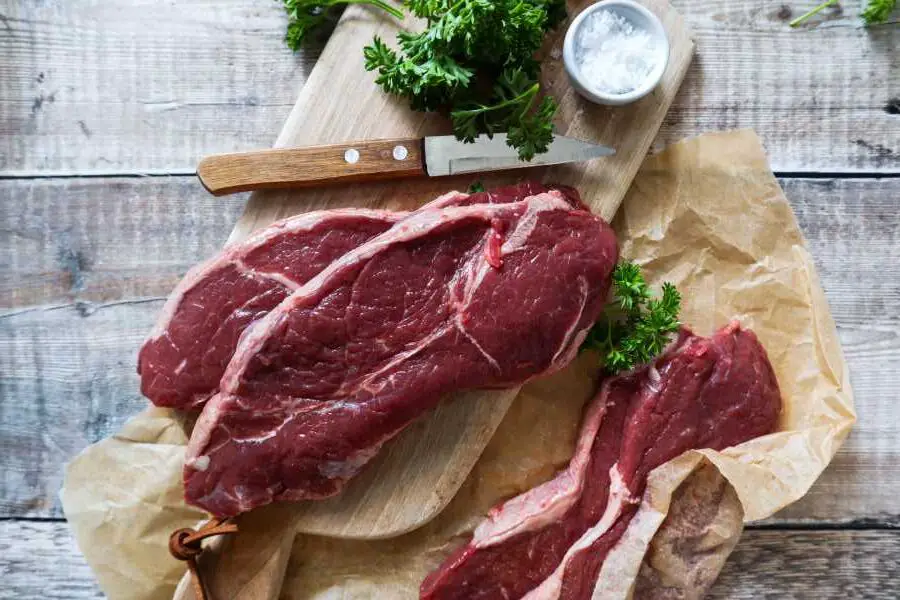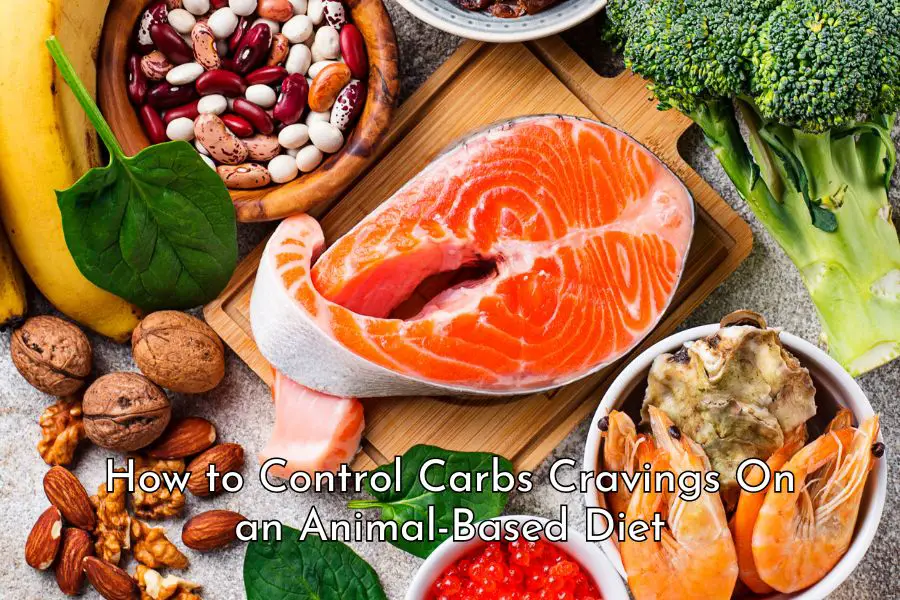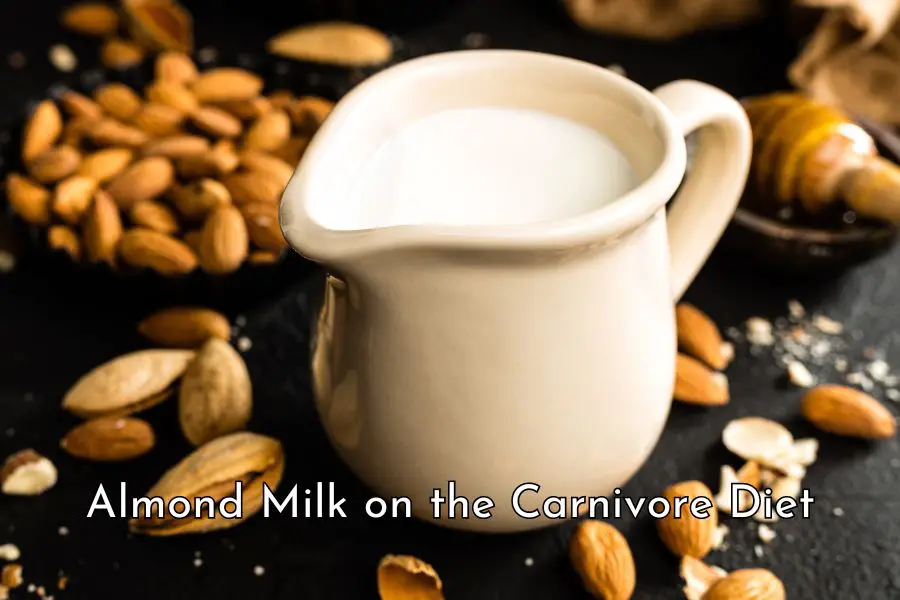In a previous post on the topic of doing the carnivore diet on a budget, I have talked about how you can save a lot of money on the carnivore diet and how to create nutritious meals on a budget. In this post, I will provide some sample meal plans that can meet all your nutritional needs even on an extreme budget.
I will first provide a list of carnivore food that you can use to create your budget meal plans and then provide some sample meal plans for three versions of the carnivore diet: a strict carnivore version, a broad carnivore version, and an ancestral carnivore version.
Carnivore diet on a budget food list
Below is a list of food that you can use to create your budget meals.
1. Ruminant meat
Get the cheapest cuts of meat you can afford from ruminants such as beef, lamb, bison, kangaroo, and buffalo.
As I wrote in this post, given today’s farming practice, the best meat to eat is ruminant meat.
Ruminants are better raised than pigs and chickens. They are also more consistent with what our ancestors used to eat. Our ancestors used to dine on large herbivores and drove them to extinction.[1] The closest you can get to large herbivores these days are ruminants like bison, cows, elks, and buffaloes, not pigs, chickens, turkeys, and ducks.
So, focus on ruminant meat and get any cheap cuts that you can afford like chuck, flank, brisket, shin, leg, and offcuts.
They may not be as tender as the more expensive cuts but just as nutritious and tasty.
Ground meat is also generally very cheap.
2. Ruminant organ
As previously mentioned in this post, ruminant organs should be a prominent figure of your diet if you are doing the carnivore diet on the budget. This is because organ meat is super nutritious and currently very cheap. Incorporating it into your diet will help you meet all your nutritional needs easier and cheaper.
Get any organ meat that you are comfortable eating, but I would prioritize liver because of its superior nutritional profile. Please check out this post for nutritional information on some organ meat.
Here are the potential choices:
- Liver
- Heart
- Tongue
- Kidney
- Testicle
- Tripe
- Bone marrow
- Brain
- Lung
- Bones
- Pancreas
- Oxtail
- Beef tendon
- Lamb hoof.
3. Other meat
The quality of other meat like pork and poultry is not as high as that of ruminant meat because of the conditions in which these farmed animals are raised and the diets they are fed. Please read this post for further detail on this subject.
My view is that you should stay away from pork and poultry if you are on a budget because:
- They are high in polyunsaturated fats which are inflammatory
- The lean options for pork and poultry are usually expensive and you’d be better off eating ruminant meat which are cheaper and healthier.
However, if you happen to find pasture-raised pork and poultry that are cheap, definitely go for it.
If you like to add conventional pork and poultry for variety, eat them sparingly.
4. Seafood
Similar to pork and poultry, farmed fish is raised in poor condition. If you happen to find cheap wild-caught seafood, go for it, otherwise, stay away from farmed fish. They are raised in crowded and polluted environments and are given antibiotics and injected vaccines. You can get omega 3 fatty acids from eating ruminant meat and organ meat. For example, beef brain is especially high in omega 3 fatty acids.
If you enjoy seafood and can’t afford to pay for wild-caught, have it sparingly. Aim for fatty fish like salmon, sardines, trout, mackerel, and herring.
Canned wild-caught fish is an alternative cheap option, but have it sparingly too due to the concern that BPA can leach from the can lining into your food.
5. Dairy
If you can tolerate and enjoy dairy, have it occasionally. However, you don’t have to if you don’t want to. You can get calcium from eating the soft bones leftover after making bone broth.
6. Seasonal plant food
If you follow the ancestral version of the carnivore diet, add a small amount of seasonal plant food to your meals occasionally. This is a very easy thing to do because fruits and vegetables in seasons are usually cheap due to the increase in supply.
Meal plans for the STRICT version of the carnivore diet
On the strict version of the carnivore diet, all you can eat is animal source food such as ruminant meat, pork, poultry, and seafood.
This version is suitable for those who are going through an elimination phase and those who can’t handle dairy and plant food.
It is certainly possible to meet all your nutritional needs on this strict version of the carnivore diet, however, you will need to truly eat nose to tail and incorporate a lot of organ meat in your diet.
Because organ meat isn’t for everyone especially those who are new to the carnivore diet so I have provided below 2 sample meal plans, one for those who can eat a lot of organ meat and one for those who are new to organ meat.
(i) Extremely simple OMAD meal plan for those who can eat a variety of organ meat
This is an extremely simple meal plan for those who can eat a lot of organ meat and want to keep things simple.
You’ll eat some budget steaks and whatever cheap organ meats you can get every day.
But this won’t be boring. Meat is never boring unless you force-feed yourself. Eat when you feel hungry and meat by itself is already very tasty.
Cheap cuts of meat usually have a lot of fat so you will have no problem staying in ketosis.
If you cook your meat lightly and add organ meat regularly like this, you will get all the nutrients for your body’s needs, from vitamin A, vitamin C, vitamin K down to calcium.
You don’t need to count calories, just eat until you are full and eat when you are hungry, and that’s why I haven’t put in any meat quantities.
| | ONE MEAL A DAY |
|---|---|
| MON | Seared budget steaks or offcuts (any ruminant) + 2 small slices of seared beef liver + a piece of soft bone + a small cup of bone broth |
| TUE | Seared budget steaks or offcuts (any ruminant) + 2 lamb kidneys + a small cup of bone broth |
| WED | Seared budget steaks or offcuts (any ruminant) + 2 small slices of seared beef liver + a small cup of bone broth |
| THU | Seared budget steaks or offcuts (any ruminant) + one beef heart stirfry + a piece of soft bone + a small cup of bone broth |
| FRI | Seared budget steaks or offcuts (any ruminant) + 2 small slices of seared beef liver + a small cup of bone broth |
| SAT | Seared budget steaks or offcuts (any ruminant) + roasted bone marrow + a small cup of bone broth |
| SUN | Seared budget steaks or offcuts (any ruminant) + 2 lamb brain fried + a small cup of bone broth |
(ii) Two meal a day meal plan for those who can eat a variety of organ meat
The sample meal plan below has two meals a day which is mostly what people would need on the carnivore diet. But if you want to have three meals a day, just eat the leftover for breakfast or cook up a cheap steak. Nothing is more fulfilling and satisfying than a steak to start the day with.
The lunch options are simpler because I assume that most of you would do that at work. If you don’t want to be questioned about why there is no fruit or vegetables in your lunch box, add some for garnishing purposes and just don’t eat them.
Dinner options have some choices that you can share with the rest of your family even if they are not on the carnivore diet.
Burger patties and meatballs should be made from ground ruminant meat like beef, lamb, roo, buffalo or bison.
| | LUNCH | DINNER |
|---|---|---|
| MON | Burger patties + slow-cooked beef tongue | Roast meat (any ruminant) + 2 small slices of seared beef liver + a small cup of bone broth + a piece of soft bone |
| TUE | Seared budget steaks (any ruminant) | Meatloaf slices + roasted bone marrow + a small cup of bone broth |
| WED | Meatballs + Beef heart steak | Seared budget steaks (any ruminant) + stirfried lamb heart + a small cup of bone broth |
| THU | Roast meat (any ruminant) + 2 lamb kidneys | Meatballs + 2 small slices of seared beef liver + a small cup of bone broth + a piece of soft bone |
| FRI | Seared budget steaks (any ruminant) | Stewed meat +oxtail soup + a small cup of bone broth |
| SAT | Meatloaf slices+ beef tendon stew | Roast meat (any ruminant) + fried lamb brains + a small cup of bone broth |
| SUN | Seared budget steaks (any ruminant) | Seared budget steaks (any ruminant) + stirfried tripe + a small cup of bone broth |
(iii) Meal plans for those who is new to organ meat
If you are new to organ meat and not ready to include organ meat regularly in your meals, you will need to have more variety in your diet.
In the meal plan below, I have included pate which can be made from beef, pork, or lamb liver and is generally more palatable than seared liver for many people.
Other organ meat such as kidneys, heart, and tongue is also absent, but I’ve kept oxtail and bone marrow which are generally more acceptable than other organ meat.
I’ve also kept a small cup of bone broth every day which is a great source of collagen, gelatin, glycine, proline, glutamine, and has a small quantity of a range of minerals.
Fatty fish or canned fish such as sardines are added for a boost in omega 3 fatty acids.
| | LUNCH | DINNER |
|---|---|---|
| MON | Burger patties | Roast meat (any ruminant) + 2 tbs pate + a small cup of bone broth + a piece of soft bone |
| TUE | Seared budget steaks (any ruminant) | Meatloaf slices + roasted bone marrow + a small cup of bone broth |
| WED | Meatballs | Seared budget steaks (any ruminant) + 2 tbs pate + a small cup of bone broth |
| THU | Roast meat (any ruminant) | Meatballs + panfry fatty fish or canned fish + a small cup of bone broth |
| FRI | Seared budget steaks (any ruminant) | Stewed meat (any ruminant) + oxtail soup + a small cup of bone broth + a piece of soft bone |
| SAT | Meatloaf slices | Roast meat (any ruminant) + 2 tbs pate + a small cup of bone broth |
| SUN | Seared budget steaks (any ruminant) | Seared budget steaks (any ruminant) + panfry fatty fish or canned fish + a small cup of bone broth |
Meal plan for the BROAD version of the carnivore diet
On the broad version of the carnivore diet, you can eat all animal-based food plus eggs, dairy, and honey.
This version is suitable for people who don’t have any problem eating eggs, dairy, and honey and are not trying to lose weight. Dairy and honey are generally best avoided if you are trying to lose weight due to their carb content and low satiety levels.
This meal plan is still centered around ruminant meat and ruminant organs. Eggs, cheese, and seafood are added a couple of times a week for variety.
Because of the increase in the variety of food choices, you don’t need to eat a variety of organ meat and still get all the nutrients that your body needs.
| | LUNCH | DINNER |
|---|---|---|
| MON | Burger patties + 2 panfry eggs | Roast meat (any ruminant) + 2 small slices of seared beef liver + a small cup of bone broth + a piece of hard cheese |
| TUE | Seared budget steaks (any ruminant) | Meatloaf slices + roasted bone marrow + a small cup of bone broth |
| WED | Meatballs | Seared budget steaks (any ruminant) + 2 small slices of seared beef liver + a small cup of bone broth |
| THU | Roast meat (any ruminant) + 2 panfry eggs | Meatballs + panfry fatty fish or canned fish + a small cup of bone broth |
| FRI | Seared budget steaks (any ruminant) | Stewed meat (any ruminant) + oxtail soup + a small cup of bone broth + a piece of hard cheese |
| SAT | Meatloaf slices | Roast meat (any ruminant) + 2 tbs pate + a small cup of bone broth |
| SUN | Seared budget steaks (any ruminant) | Seared budget steaks (any ruminant) + panfry fatty fish or canned fish + a small cup of bone broth |
Meal plan for the ANCESTRAL version of the carnivore diet
On the ancestral version of the carnivore diet, you can eat all animal source food including ruminant, pork, poultry, seafood, eggs, dairy, and honey, plus a small amount of seasonal plant food.
This is more consistent with how our ancestors would have eaten. They ate mostly meat throughout evolution history but would have eaten plant food too to survive when meat was not available.
This version of the carnivore diet is for those who don’t have any food intolerance problems and are metabolically healthy.
The meal plan below is the same as above except that seasonal plant food appears three times a week. Simply adding a small serving of fruits or vegetables a few times a week will help you meet your nutritional needs easier.
Adding some plant food also helps you to keep metabolic flexibility in that you are unlikely to get sick if for whatever reasons you need to switch to a more plant-based diet to survive.
This way of eating is also more socially acceptable than going strictly carnivore.
| | LUNCH | DINNER |
|---|---|---|
| MON | Burger patties + 2 panfry eggs + seasonal fruit/vegetables | Roast meat (any ruminant) + 2 small slices of seared beef liver + a small cup of bone broth + a piece of hard cheese |
| TUE | Seared budget steaks | Meatloaf slices + roasted bone marrow + a small cup of bone broth |
| WED | Meatballs + seasonal fruit/vegetables | Seared budget steaks + 2 small slices of seared beef liver + a small cup of bone broth |
| THU | Roast meat (any ruminant) + 2 panfry eggs | Meatballs + panfry fatty fish or canned fish + a small cup of bone broth |
| FRI | Seared budget steaks | Stewed meat + oxtail soup + a small cup of bone broth + a piece of hard cheese |
| SAT | Meatloaf slices + seasonal fruit/vegetables | Roast meat (any ruminant) + 2 tbs pate + a small cup of bone broth |
| SUN | Seared budget steaks | Seared budget steaks + panfry fatty fish or canned fish + a small cup of bone broth |
Ruminant alternatives
The above meal plans are centered around ruminant meat. If you don’t have access to ruminant meat, can’t afford it, or don’t eat for whatever reasons, replace them with cheap pork, poultry, or fish. By eliminating processed food, industrial seed oils, junk food, grains, etc., you are still doing a lot better than if you were still on the SAD diet.
If you find this post helpful, please consider sharing this post and my site with your family, friends, and followers. That would be much appreciated. Please also check out my library of articles on the carnivore diet here which is updated regularly.
Disclaimer: The information in this post is for reference purposes only and not intended to constitute or replace professional medical advice. Please consult a qualified medical professional before making any changes to your diet or lifestyle.
Photo credit: Leonora Brebner on Pexels





